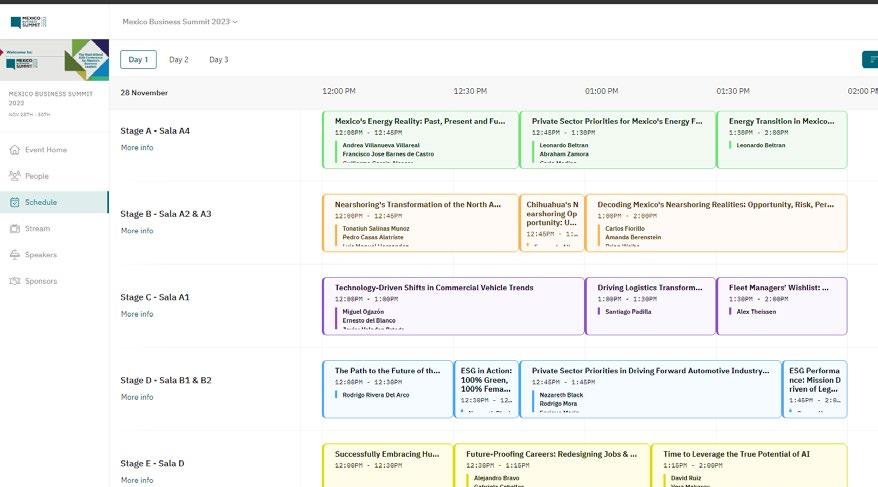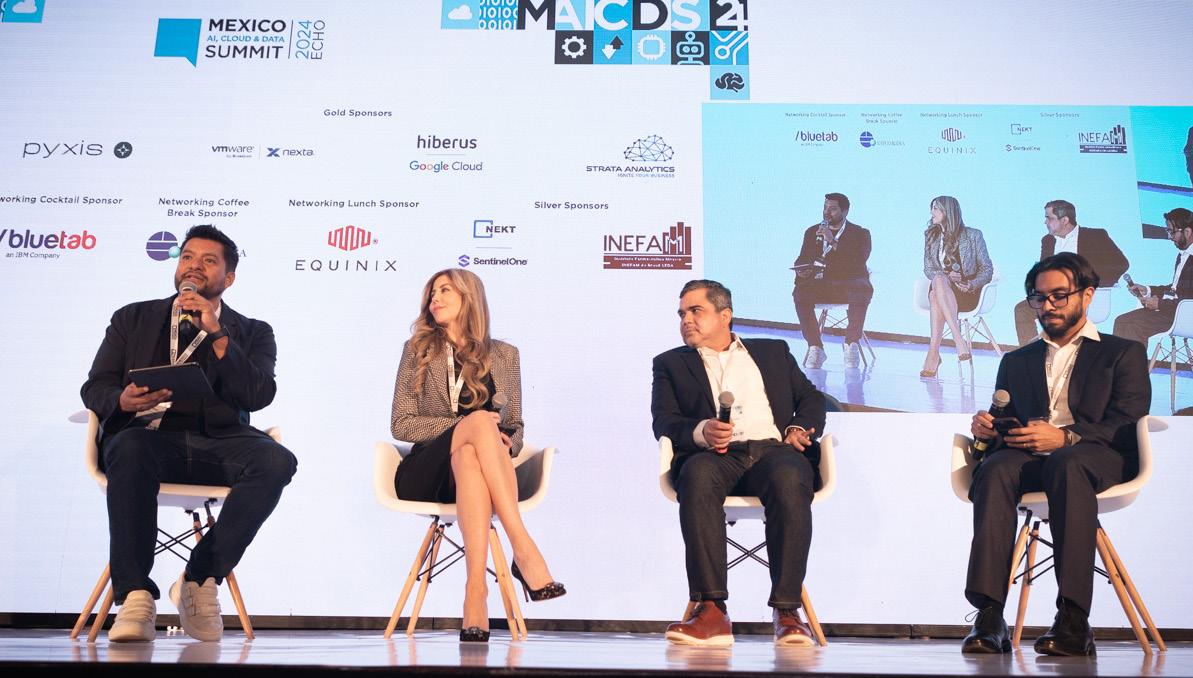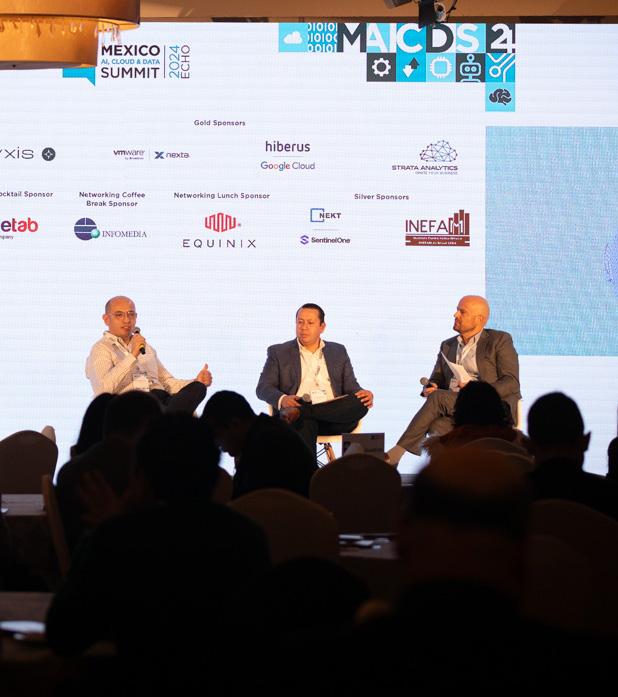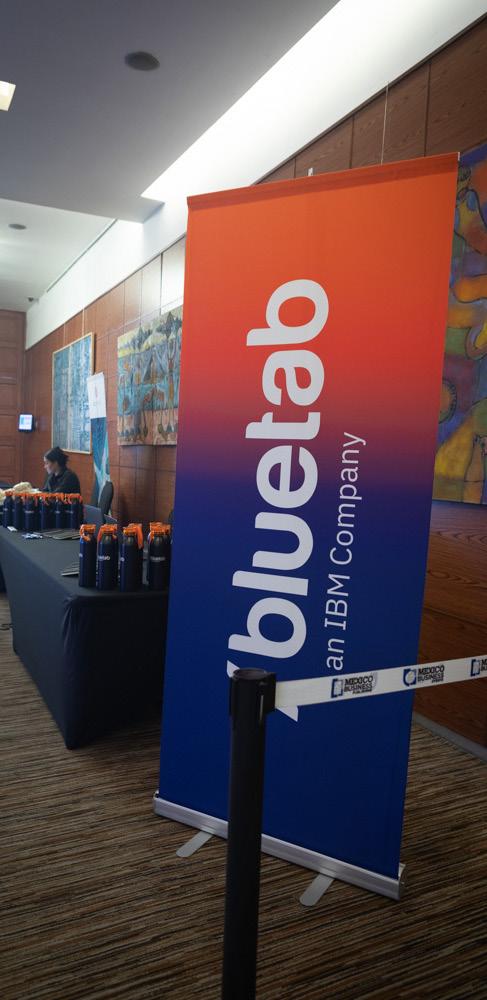

IMPACT REPORT
Matchmaking Sponsor
Gold Sponsors
Networking Cocktail Sponsor
Networking Lunch Sponsor
Networking Coffee Break Sponsor
Silver Sponsors
80 companies
232 conference participants
Breakdown by job title
22 speakers
3rd Edition
8 sponsors
7,588 visits to the conference website
click through rate during MAICDS
pre-conference click through rate
Matchmaking
Mexico’s leading B2B conference organizer uses a customized app to deliver an unparalleled experience
The MBE App delivered AI-powered intent-based matchmaking to Mexico AI, Cloud and Data Summit 2024 Echo attendees
App Impact
232 participants
173 matchmaking communications



25 1:1 meetings conducted Matchmaking intentions
Trading 201 Networking


• 99minutos
• ALCON
• Arena Analytics
• ArGO-EFESO
• ASAMEp
• Banorte
• BBVA
• Benotto
• Bluetab
• Bluetab An Ibm Company
• Brella Ltd
• Broadcom
• Cámara Mexicano-Alemana de Comercio e Industria
• CAAAr EM
• CAMAr A DE COMErCIO Y TECNOLOGIA ME XICO-CHINA
• Cámara Española De Comercio En México
• Camexa
• Category Ideas SC
• CENACE
• Cloudera
• CNBV
• Codelarc consulting
• Cognitus IT Solutions
• COMCE Sur
• Coppel
• CriskCo
• Delegación General de Québec en México
• Desarrolladora del parque, SA de CV
• DEUNA
• DHL Global Forwarding
• Dylo Inc
• Embajada de CanadáGobierno de Ontario
• Enfoque Digital
• EQUINIX
• Erp Integra
• Exitus Capital
• Gibhor Smart Services SAS de CV
• Global Hitss
• Grupo Financiero Banorte
• Grupo restaurantero LCT
• GrupoBeIT
• Hiberus
• H ICV Mexico
• Hooman
• I E stratégica
• Iberdrola
• INAI
• Inception
• INFOMEDIA
• Ingenieria integral
• Interproteccion
• Johnson Controls
• J rr
• La Casa de Toño
• Latinas In Tech
• Microsoft Mexico
• Mutt Data
• NEKT Group
• Nexta
• Nissan
• Nokia
• Omiwave
• pALO IT
• proa
• provident México
• prudential Seguros Mexico
• p yxis
• r . S. y Asociados
• Stanley Black & Decker
• Stragia
• Strata Analytics
• Tbsek
• TECNOLOGÍA O rIENTADA AL SErVICIO SA DE C V (Mexico)
• Thomson reuters
• T-Note
• Traxión
• Von Wobeser y Sierra, S.C.
• Walmart De México Y Centroamérica
• Yakatiak, Consultores Y Asoc., S. A. De C.V.
• Zscaler

DATA ECOSYSTEM: EXPANDING MEXICO’S BUSINES S FRONTIER
While transparency and public access to information have long been recognized as critical to fostering social and economic development, significant barriers remain in translating Open Data into actionable insights for effective decision-making, says Adrián Alcalá, Commissioner president of the National Institute for Transparency, Access to Information, and protection of p ersonal Data (INAI).
He highlights a key issue: the inconsistent quality and accessibility of data across various government levels. This fragmentation hampers the potential of Open Data to drive substantial progress in areas such as anticorruption efforts, disaster response, and financial transparency.
To address these gaps, Mexico’s “Open Mexico” strategy, approved in October 2023, lays the groundwork for a cohesive data ecosystem that supports the generation, dissemination, and utilization of Open Data across all tiers of government. By aligning with the General Law of Transparency and Access to public Information (LGTAIp) and adhering to international standards like the International Open Data Charter, the initiative aims to modernize how data is managed and applied within the country.
At the core of this strategy is the integration of Open Data into decision-making processes, ensuring that data is not only available but also leveraged effectively. Key objectives include fostering the analysis and repurpose of data to promote innovation and more informed public policies. This framework emphasizes the need for accessible, high-quality data

“Standards allow open data to serve as a foundation for innovation and public policy, ensuring compliance with both national and international regulations”
Adrián Alcalá President Commissioner | INAI
that can be used by both public and private sectors to generate meaningful outcomes.
The advantages of open data are extensive, positioning it as a crucial asset in our society and the foundation of effective decisionmaking. “When digital resources are open and accessible, they can yield significant benefits across various sectors, contingent on their effective application,” says Alcalá.
In the context of natural disasters, for example, open data can pinpoint locations for aid distribution and provide real-time communication. These capabilities have been critical during past earthquakes and could have provided essential support during recent events, such as Hurricane Otis. Beyond disaster response, open data enhances the monitoring of healthcare systems, facilitating the identification of public health challenges and medication shortages.
According to INAI, leveraging geo-referenced data is essential for combating poverty and ensuring transparency in public spending. The availability of open datasets allows for the identification of vulnerable communities and supports the tracking of government expenditures, ensuring that resources are allocated in alignment with established priorities. By enabling stakeholders to analyze trends and allocate resources effectively, open data fosters a more responsive and accountable public health infrastructure.
For stakeholders to effectively leverage open data, standardization is essential, emphasizes Alcalá. Standards play a crucial role in ensuring consistency, accessibility, and interoperability, which are vital for integrating datasets from multiple sources. By establishing a unified framework, standards allow Open Data to be leveraged for innovation, informed public policies, and compliance with national and international regulations.
Among the benefits, standards promote compatibility by providing a common structure that facilitates use of data

across different systems and applications, enhance the analysis and comparison of data from various sources, and improve data organization and accessibility, making information more searchable and usable. By enabling the integration of datasets under a cohesive framework, standards ensure that open data can be efficiently reused for multiple purposes.
Despite the objectives of INAI’s Abramos Mexico initiative to establish a comprehensive National Open Data p olicy through collaboration between civil society and the public sector, many governmental entities still struggle to optimize their use of available data. This shortcoming significantly hinders their capacity to conduct in-depth analyses that could enhance public policies and inform business decisions. Adrián Alcalá emphasized this point during the MAICDS 2024, highlighting the urgent need for entities to leverage open data effectively to drive improvements in governance and economic performance.
Main Challenges:
+ Data Quality: Many available datasets lack consistency and updating, which hinders their effective use in analysis and decision-making.
+ Limited Technical Capacity: Both the public and private sectors face challenges in training personnel to manage, analyze, and exploit open data. Without significant investment in training, the potential of data will remain untapped.
+ Culture of Openness: While access to data is guaranteed by law, there is a lack of organizational culture geared towards data-driven decision-making. Without an institutional shift towards transparency and innovation, adoption of these policies will be limited.
+ Insufficient Technological Infrastructure: Interoperability between systems remains an obstacle. Data platforms must be aligned with international standards to ensure greater connectivity and leveraging of information.
In the long term, initiatives like Abramos Mexico and integration with the National AI plan (planDAI) is expected to establish a robust and sustainable open data ecosystem. According to Alcalá, “in the coming years, interoperability and data quality will improve, driving greater multi-sector collaboration between government, business, academia and civil society.” He emphasized the critical role of collaboration in achieving these goals, noting that citizen participation and multidisciplinary teams can enhance the relevance of data and stimulate innovation.
To foster civil participation, mechanisms such as hackathons, social innovation labs, and local open data networks will enable citizens to engage more actively, allowing open data to be utilized innovatively to address social and economic challenges. In addition, the use of geo-referenced data and transparency in public spending will be key areas where open data can generate a transformative impact.
“With a continued commitment to open data, Mexico can consolidate itself as a regional leader in transparency and the use of open data, allowing both the public and private sectors to make more informed decisions aligned with the needs of society,” concluded Alcalá.
BEYOND BORDERS: MEXICO’S DATA CENTER BOOM AND GLO BAL IMPACT
As the demand for cloud computing, AI, and digital transformation grows, Mexico is positioning itself as a global data center powerhouse. Favorable geopolitical conditions, a strong talent pool, and the growing importance of sustainability and energy efficiency are all contributing to this rapid expansion, according to Josué ramírez, Founder, Jrr IT Consulting.
Mexico has established itself as a strategic hub for the global data center industry, leveraging its geographic location, existing infrastructure, and skilled workforce. With a projected investment of more than US$1 billion by 2028, the country is positioning itself as a key player in the global market. “Mexico is undergoing a new industrial revolution through data center growth,” said ramírez, predicting a 5x increase in digital infrastructure in the coming years.
“Geopolitical tensions present challenges, but they also offer Mexico an opportunity to become a leader in digital infrastructure,” explained Carlos Zamora, LATAM Datacenter GTM Lead, Microsoft Mexico. Mexico’s proximity to the United States, its moderated climate, and its tech talent pool make it a magnet for cloud providers and IT investments.
Over the next five years, an estimated 38 GW of new IT infrastructure will be deployed globally, with Mexico poised to play a key role in addressing increasing compute demand, according to Miguel ramos, Global Director of Operations, Kio Data Centers. Queretaro and Monterrey alone will receive a significant portion of that capacity. But despite the significant potential of this emerging industry, it faces substantial challenges that could limit its growth. The primary obstacle is the limited availability of reliable electrical infrastructure, which is critical to the operation of data centers and the environmental sustainability of these centers.
Leading tech companies, such as Meta, Microsoft, and Google, have unveiled plans for projects totaling over one gigawatt in capacity, with OpenAI even announcing intentions for a substantial 5-gigawatt facility. While these developments are not based in Mexico, they highlight the increasing global demand for data processing and storage capabilities, which presents an opportunity for Mexico to attract similar investments in its data center infrastructure.
“With these investments, energy availability becomes more critical, and it has been increasingly difficult to concentrate such


to replace the human factor.” Instead, she advocates for a strategic framework in which businesses define their objectives with data to ensure alignment with operational goals. “A timely alert translates into revenue for the company,” she noted, underlining the necessity for organizations to harness data effectively.
Fernando Treviño, Deputy General Manager of Technology, Banorte, echoed this perspective, highlighting the necessity of centering the customer in the decisionmaking process. “We need to know why customers prefer us,” indicating that data— ranging from geographical to operational— plays a vital role in understanding customer preferences. Simple gestures, like sending birthday greetings, can create memorable experiences that deepen customer loyalty,” says Treviño.
Transforming customer experiences through data involves a thorough analysis of operational records and activity logs. Treviño illustrated this by explaining how insights derived from transaction histories can inform targeted offers, such as mini loans for customers facing a cash shortfall. “The cherry on top is our personalization,” he added, showcasing how integrating human and digital interactions can create tailored experiences.
“This data represents the reality of the business,” Karla Almeida, Head of Data at 99 Minutos as she advocated for adherence to quality data standards to generate meaningful insights. She highlighted the significant potential of utilizing public and synthetic datasets to enhance data quality, allowing organizations to establish strategic partnerships that provide access to richer data resources.
The caveat regarding data quality is particularly pertinent, as Adrián Álvarez del Castillo, partner and Head of Analytics & AI, INFOMEDIA, noted that not all data generated holds significant value. “We need to reflect on which data is worth utilizing,” he advised, urging companies to avoid analyzing data that does not yield actionable insights.
In addition to maintaining clean data, implementing a robust data governance framework is equally essential to guaranteeing data quality and reliability. This emphasis on governance underscores the sentiment that “data quality is crucial; we do not want to generate garbage information.” Clean, wellgoverned data is vital for supporting effective decision-making within organizations.
Ana Coronel, Data Science V p, BanBajio, reinforced the importance of integrating data from various sources. “We are building a data factory to gradually integrate information,”
she explained, emphasizing the need for trustworthy data to inform business decisions.
As organizations explore ways to leverage operational intelligence, emerging technologies play a pivotal role. Treviño emphasized the significance of advanced tools capable of reading, writing, and interpreting data, which can enhance traceability and analysis capabilities. He remarked, “The most important thing is the strategy: what you seek and how to achieve it.”
Finally, staff training emerges as a critical factor in maximizing the potential of operational intelligence. Organizations must ensure that their teams are well-equipped to utilize these tools and interpret the insights derived from data analysis. Without adequate training, the anticipated benefits of operational intelligence may not be fully realized.
Emerging technologies such as predictive analytics, decision automation, and advanced artificial intelligence are set to evolve, enhancing the capabilities of operational intelligence (OI) solutions. In the coming years, Mexican organizations will be able to leverage these advancements to anticipate problems before they arise, personalize customer experiences more accurately, and improve operational efficiency in critical areas like logistics, marketing, and customer service.
The integration of operational intelligence into business processes offers immense opportunities for those willing to embrace data as a strategic asset. The key lies in understanding the customer, ensuring data quality, and leveraging technology effectively. By transforming data into actionable insights, businesses can enhance decisionmaking capabilities and create meaningful experiences that drive growth and success in an increasingly competitive landscape.
UNLOCKING THE POTENTIAL OF MULTI-CLOUD D EPLOYMENTS
Mexico is experiencing a significant uptick in the adoption of cloud solutions; however, many organizations continue to rely on a single provider for data storage and processing. This dependency exposes them to operational risks, including service disruptions and reduced operational flexibility. Such a model constraints companies’ abilities to optimize costs, enhance resilience, and adapt their infrastructure to evolving market demands, according to industry experts.
“Adopting a multi-cloud strategy goes beyond vendor diversification; it empowers businesses to leverage each provider’s strengths, enhancing resilience and adaptability,” said Manuel rivera, Founder and CEO, NEKT Group, during the MAICDS 2024 Echo.
A challenge for Mexican companies, particularly in regulated sectors like finance and healthcare, is compliance with local regulations that necessitate stricter control over data storage and processing. According to Computer Weekly, this creates barriers to
fully leveraging cloud solutions, as sensitive data often must be stored on local servers or within private environments.
Furthermore, managing data across multiple cloud service providers, which many Mexican organizations already utilize to some extent, presents significant challenges in administration, security, and compliance. Consequently, organizations often find themselves grappling with the dilemma of choosing between cost and flexibility or between scalability and security.
Alejandro p atiño, CIO, Grupo Altex, underscored the importance of scalability in bridging the gap between technology and business. “We used to work with fixed servers, which became obsolete quickly. Moving to the cloud allowed us to measure availability and enhance the user experience,” said patiño.
Adopting a hybrid multi-cloud approach represents an optimal solution for Mexican companies seeking to enhance their
technology infrastructure. This model effectively merges the benefits of public cloud storage with on-premises resources, enabling organizations to capitalize on the economies of scale offered by cloud providers while retaining control over sensitive data through local solutions.
“A multi-cloud strategy allows enterprises to distribute workloads across various providers based on critical criteria, including cost, storage capacity, performance, compliance, and operational resilience,” said Guillermo Saynez, Head of Data and Analytics, Iconn.
This approach, according to Saynez, not only enhances flexibility but also mitigates the risks of vendor lock-in, empowering organizations to seamlessly transition their data between public and private clouds in response to evolving business needs.
Additionally, hybrid multi-cloud strategies facilitate the placement of data in the most suitable locations for each workload type, whether for business-critical applications

or data analytics services. Lastly, allowing the development of tailor solutions that meet each client’s unique needs, enhancing innovation and delivering real value.
This strategy is particularly advantageous for companies operating in heavily regulated industries, where compliance mandates often necessitate that certain data be stored in on-premises environments or private clouds to fulfill stringent security and privacy requirements.
“Many capabilities are being added to the cloud, such as artificial intelligence and quantum computing, as providers prioritize new security measures in light of sustained and evolving cybersecurity risks. However, this presents challenges in data transfer, as it is crucial to understand where and how information is moved,” said rivera.
The adoption of diverse technologies that facilitate the implementation and management of applications in distributed environments is poised to play a crucial role in the development of multi-cloud solutions in Mexico. Leading cloud providers, such as AWS, Azure, and Google Cloud, are actively investing in tools designed to simplify the management of multi-cloud environments, enabling Mexican companies to achieve centralized control over their resources.
“Implementing a multi-cloud strategy requires a clear governance model, data interoperability, and staff training. This ensures companies leverage diverse cloud strengths,” explained rivera.
In the coming years, Mexican organizations are expected to increasingly leverage hybrid multi-cloud strategies to enhance their resilience and swiftly adapt to evolving market demands. However, it will be equally important for these companies to invest in the training of their IT teams and the implementation of advanced management tools. Such investments are essential to effectively address operational challenges and ensure strict compliance with local regulations.
and methodically integrate the right tools, such as generative AI technologies,” he said.
The concept of Zero Trust is key to secure data, which needs to be implemented within the cloud architecture. “Zero Trust is not a one-size-fits-all solution but a costly architecture that adds significant value to any organization,” said Garrido. By segmenting, even micro-segmenting, access based on data sensitivity and continuously monitoring internal and external threats, Zero Trust helps ensure a higher level of security in the cloud.
As innovative technologies are widely implemented across all sectors, sustainability
is a growing concern for businesses as they seek to reduce their carbon footprint through cloud adoption. To address this, companies in Mexico are implementing a green IT approach. “Measuring carbon emissions is now a part of cloud migration, and organizations must demand their providers adopt this concept,” said Garrido.
Aligning technology and industry needs with the human factor is key for infrastructure migration. “In Mexico, the demand for migration exceeds the available resources. But with the right combination of strategy, automation, and human capital, we can achieve a smooth transition to the cloud,” concluded Lombardero.
THE DATA HORIZON: STRATEGIES FOR GEN AI-READY DATA MANAGEMENT
Generative AI has captured the imagination of the business world, paving the way for democratized access to advanced technologies. David r uiz, Head of Data Analytics, Google Cloud emphasizes that this shift allows individuals in non-technical roles—such as marketing and sales—to utilize AI effectively. The challenge lies in translating this potential into actionable key performance indicators (KpIs) that can drive real results.
Businesses that effectively leverage artificial intelligence (AI) can achieve significant results. For example, ruiz notes that some companies have seen up to a 19% increase in order value and four times greater inventory visibility. The 19% increase comes from AI’s ability to analyze customer data and optimize product recommendations, pricing strategies, and promotions, which encourages customers to spend more per transaction.

To improve customer interactions, businesses often generate hyper-personalized offers
“AI is not for everyone, and it may not be suitable for all situations”
David Ruiz Head of Data Analytics & AI | Google Cloud
that resonate with individual preferences. However, while hyper-personalization is valuable, r uiz explained how it should be balanced with strategies that focus on identifying key customer segments.
rather than targeting every individual with personalized offers, businesses can benefit from also identifying their most valuable customers and providing them with relevant, high-impact propositions. This combination of hyper-personalization and targeted, strategic offers ensures businesses maximize their resources and enhance overall customer relationships without overwhelming or alienating other customer segments.
The potential of data extends beyond traditional analytics. Companies must leverage all available data to uncover insights and assign specific value to each data point. “Often, we fail to realize what valuable information we have at our fingertips,” ruiz points out. This perspective becomes essential for organizations seeking to refine their data management approaches.
Given that data types can vary significantly— illustrated by the difference between quantitative survey responses and qualitative feedback—businesses often mismanage data by focusing solely on numeric scores.
This oversight can lead to the loss of richer insights. Therefore, a holistic approach to data utilization is crucial, ensuring that organizations make informed decisions based on comprehensive datasets.
For example, transactional e-commerce data requires distinct storage solutions that may not align with traditional data management practices. ruiz advocates for the integrating diverse data types across platforms, allowing organizations to extract maximum value regardless of data location. However, he cautions.
As organizations evolve, they must be vigilant about hidden risks that can undermine their data management efforts. r uiz identifies three significant risks: isolated data solutions, disconnected strategies for data and AI, and over-reliance on business intelligence tools. He argues that these pitfalls can hinder effective decision-making by limiting access to critical information.
To address these challenges, organizations should adopt a unified approach to data
and AI management, r uiz suggests. This involves establishing a cohesive framework that integrates data warehouses, lakes, and analytics solutions. By breaking down silos between analytical and transactional data, businesses can streamline operations and enhance overall efficiency.
Despite these advancements, data privacy remains a paramount concern for organizations utilizing cloud solutions. ruiz highlights the importance of ensuring that uploaded data is exclusively accessible to the customer, adhering to Google’s principle of “Your data, your terms.” This approach fosters trust and accountability in data management practices.
A unified data and AI platform is essential for organizations looking to thrive in the digital age and unlock the full potential of this technology. By implementing strategies that prioritize data governance, integration, and real-time processing, businesses can reduce the risks associated with data management while maximizing the value derived from their data assets.
RESPONSIBLE AI DEVELOPMENT AND DATA PRIVACY PROTECTION
The transformative potential of artificial intelligence (AI) in the Mexican business environment is undeniable, as many organizations are integrating AI into their growth strategies to gain competitive advantages. However, as AI applications grow, so do the challenges associated with its responsible use, particularly in personal data protection and ethical and social risk management. To ensure the responsible development of AI, industry experts say organizations must prioritize transparency and accountability in their AI initiatives.
The use of generative AI (GenAI), in particular, offers advanced capabilities such as the generation of text, images, code and simulations, which increases business efficiency. However, this ability to generate new content from vast data sets raises important questions about data privacy
and security. Consequently, organizations must be transparent about how they collect, store, and process data to ensure that user privacy is protected and that personal information is not misused. “Generative AI serves to create content, utilizing data provided by clients with the trust that it will be used effectively to deliver benefits,” says Javier Hauss, Co-Founder, Chief Data & AI Officer, Bineo.
While Mexico has enacted a Federal Law for the protection of personal Data in possession of Individuals, it has not sufficiently evolved to address the unique challenges posed by AI technologies. Issues such as security breaches, algorithmic biases, and a lack of transparency in automated decision-making processes require more thorough exploration to foster trust among employees and consumers alike.
In the long term, the adoption of artificial intelligence (AI) in Mexico is anticipated to cultivate an environment where consumer trust and personal data security take precedence. With robust legal frameworks and ethical AI practices in place, Mexico has the potential to set a benchmark for responsible AI innovation in the region. This leadership can pave the way for the establishment of standards that promote an ecosystem where AI is leveraged for societal benefit while safeguarding privacy and ensuring fairness.
Looking ahead, as the emphasis on transparent and responsible AI intensifies,
Mexican companies are poised to enhance their international competitiveness. This enhancement will stem not only from the implementation of innovative solutions but also from a commitment to ensuring that their AI systems are equitable, fair, and respectful of human rights.
“Creating a robust infrastructure to manage and facilitate AI is crucial for driving innovation while ensuring compliance and ethical use. This foundation empowers organizations to harness AI’s full potential without compromising data privacy or security,” said Alejandro r obles, Senior regional Sales Director Mexico, Broadcom.
BEYOND GENERATIVE AI: CAUSAL AI TRANSFORMING BUSINESS STRATEGIES

Leveraging advanced analytics to drive decision-making is essential for maintaining a competitive edge in modern business. Yet, while traditional statistical methods have long been used to identify patterns and predict outcomes, they often fall short of explaining the “why” behind those outcomes, according to expert Sebastián García, AI & Data Solutions Expert, p yxsis. With causal inference, models go beyond correlation to uncover the cause-and-effect relationships between variables.
A key limitation of traditional statistical tools is that they are excellent at detecting correlations but often fail to explain causality. “This is where causal inference makes a difference,” said García. “By asking deeper questions—such as ‘What will happen if this scenario did not happen?’—causal inference allows businesses to go beyond what is likely to happen, to retrospect and imagine, and focus on how they can influence outcomes.”
Causal inference can be applied across multiple areas of business, driving more effective strategies in key areas such as supply chain optimization, customer retention, and manufacturing process efficiency. “Businesses that adopt causal inference are better positioned to make data-driven decisions that go beyond correlation, unlocking more







